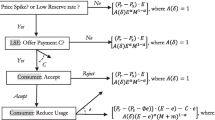Conclusion
In the preceding discussion, the price responsiveness of consumers has been estimated. The results not only indicate consumer reaction to changes in price is significant, but also they should completely dispel any argument over the efficacy of the market mechanism to restore equilibrium between supply and demand. Note, however, that demand is relatively inelastic, implying that a large change in price is needed to induce a sufficient change in the quantity demanded for the restoration of equilibrium. If the problem is to curtail the sales of electricial energy, the solution is obvious.
Similar content being viewed by others
References
Bureau of Labor Statistics,Employment and Earnings, U.S. Government Printing Office, Washington, monthly.
Y. Grumfeld and Z. Griliches, “Is Aggregation Necessarily Bad?,”Review of Economics and Statistics, 42, February 1960.
J. Henderson and R. E. Quandt,Microeconomic Theory, 2nd ed., New York: McGraw-Hill Book Company, 1971.
H. S. Houthakker and L. D. Taylor,Consumer Demand in the United States: Analyses and Projections, Harvard University Press, Cambridge, 1970.
A. Koutsoyiannis,Theory of Econometrics, New York: Barnes and Noble, 1973.
N. Liviatan, “Consistent Estimation of Distributed Lags,”International Economic Review, 4, January 1963.
M. Lovell, “Seasonal Adjustment of Economic Time Series and Multiple Regression Analysis,”Journal of the American Statistical Association, 63, December 1963.
N. D. Uri,Towards An Efficient Allocation of Electrical Energy, Lexington: D. C. Heath and Company, 1975.
N. D. Uri, “A New Approach to Load Forecasting in the Electrical Energy Industry,” BLS Working Paper No. 31, November 1974.
A. Zellner, “An Efficient Method of Estimating Seemingly Unrelated Regressions and Tests for Aggregation Bias,”Journal of the American Statistical Association, 57, June 1962.
Author information
Authors and Affiliations
Additional information
The author would like to thank Joseph R. Antos and J. Wilson Mixon of the Bureau of Labor Statistics for helpful comments. The views expressed are those of the author and do not reflect the policies of the Bureau of Labor Statistics or the views of other BLS staff members.
Rights and permissions
About this article
Cite this article
Uri, N.D. A dynamic demand analysis for electrical energy by class of consumer. Atlantic Economic Journal 4, 33–38 (1976). https://doi.org/10.1007/BF02304278
Issue Date:
DOI: https://doi.org/10.1007/BF02304278




